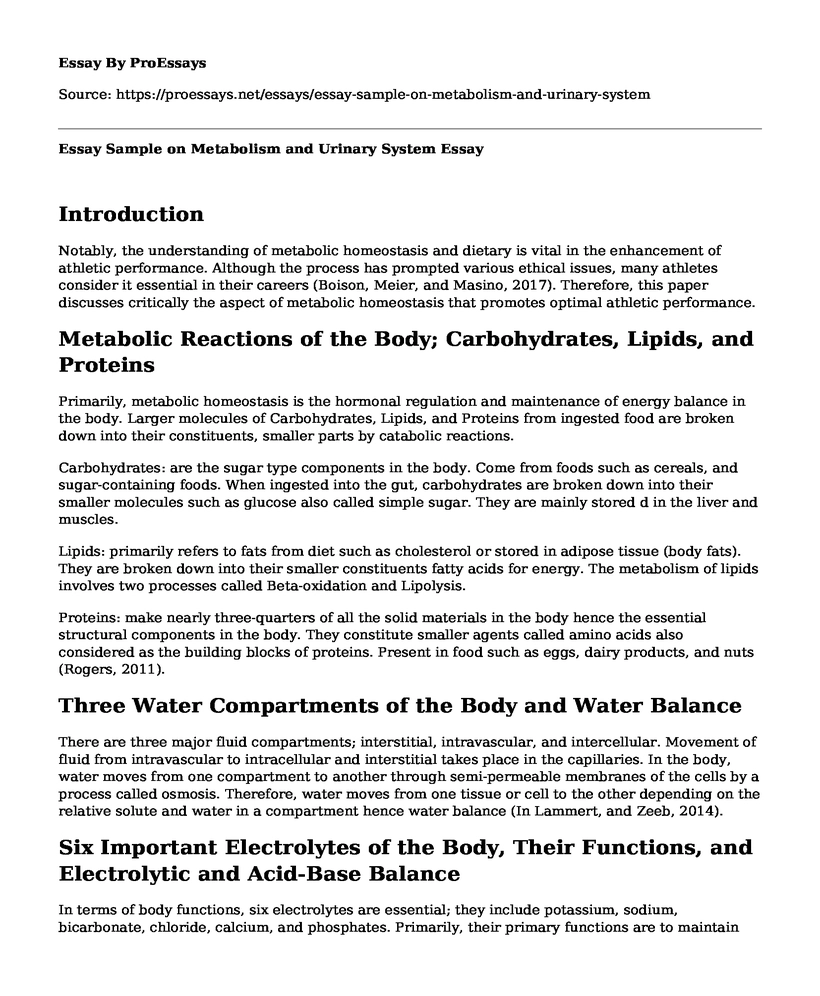Introduction
Notably, the understanding of metabolic homeostasis and dietary is vital in the enhancement of athletic performance. Although the process has prompted various ethical issues, many athletes consider it essential in their careers (Boison, Meier, and Masino, 2017). Therefore, this paper discusses critically the aspect of metabolic homeostasis that promotes optimal athletic performance.
Metabolic Reactions of the Body; Carbohydrates, Lipids, and Proteins
Primarily, metabolic homeostasis is the hormonal regulation and maintenance of energy balance in the body. Larger molecules of Carbohydrates, Lipids, and Proteins from ingested food are broken down into their constituents, smaller parts by catabolic reactions.
Carbohydrates: are the sugar type components in the body. Come from foods such as cereals, and sugar-containing foods. When ingested into the gut, carbohydrates are broken down into their smaller molecules such as glucose also called simple sugar. They are mainly stored d in the liver and muscles.
Lipids: primarily refers to fats from diet such as cholesterol or stored in adipose tissue (body fats). They are broken down into their smaller constituents fatty acids for energy. The metabolism of lipids involves two processes called Beta-oxidation and Lipolysis.
Proteins: make nearly three-quarters of all the solid materials in the body hence the essential structural components in the body. They constitute smaller agents called amino acids also considered as the building blocks of proteins. Present in food such as eggs, dairy products, and nuts (Rogers, 2011).
Three Water Compartments of the Body and Water Balance
There are three major fluid compartments; interstitial, intravascular, and intercellular. Movement of fluid from intravascular to intracellular and interstitial takes place in the capillaries. In the body, water moves from one compartment to another through semi-permeable membranes of the cells by a process called osmosis. Therefore, water moves from one tissue or cell to the other depending on the relative solute and water in a compartment hence water balance (In Lammert, and Zeeb, 2014).
Six Important Electrolytes of the Body, Their Functions, and Electrolytic and Acid-Base Balance
In terms of body functions, six electrolytes are essential; they include potassium, sodium, bicarbonate, chloride, calcium, and phosphates. Primarily, their primary functions are to maintain the acid-base balance they regulate muscle and nerve function, balance blood acid and pressure, hydrate the body and assist rebuild the damaged tissues.
Electrolytes themselves regulate water and acid-base balance in the blood in case of imbalance they are moving actively across the cells by active transport to adjust fluid levels. Kidneys and respiratory systems regulate acid-base balance by maintaining the equilibrium between proton acceptors and proton dormers in the buffering process of blood maintained at an approximate pH of 7.35 to 7.45 under normal conditions in arterial blood.
Meaning and Types of Acidosis and Alkalosis
Acidosis refers to excess acid in the blood that causes the fall in the pH below 7.35. Alkalosis, on the other hand, refers to an excess of base in the bloodstream that causes blood to rise above the pH of 7.35. There are two types of acidosis namely, metabolic acidosis and respiratory acidosis, which is categorized, based on the cause. On the other hand, there are four essential types of alkalosis namely, respiratory alkalosis, metabolic alkalosis, hypokalemic alkalosis and hypochloremic alkalosis (In Lammert, and Zeeb, 2014).
Metabolic Homeostasis for Athlete Performance and Ethical Issues
The fact is all athlete tamper with their body as they all seek to attain the optimal level of muscle endurance and performance; the question only becomes to what degree is acceptable and ethical. Some of the natural and ethical ones include special diets and training estates. Several types of research ascertain that fasted exercise improves muscles endurance than special diets as it enhances adaptation to a high level of lactic acid (In Lammert, and Zeeb, 2014). Others such as the use of performance-enhancing drugs (PEDs) are unethical and illegal. Thus the use of these drugs to enhance performance (doping) bears longtime consequences to the human body such as stroke and heart attacks.
Conclusion
In conclusion, metabolic homeostasis is central body process not only for the maintenance of body organs and functions but also for athletic performance. In much as athletes are looking for an edge to enhance their performance, even the ethical ones should be taken with caution since they behold severe health consequences.
Reference
Boison, D., Meier, J. C., & Masino, S. A. (2017). Metabolic Control of Brain Homeostasis. Place of publication not identified: Frontiers Media SA.
In Lammert, E., & In Zeeb, M. (2014). Metabolism of human diseases: Organ physiology and pathophysiology. Wien: Springer
Rogers, K. (2011). The components of life: From nucleic acids to carbohydrates. New York, NY: Britannica Educational Pub. in association with Rosen Educational Services.
Cite this page
Essay Sample on Metabolism and Urinary System. (2022, Dec 03). Retrieved from https://proessays.net/essays/essay-sample-on-metabolism-and-urinary-system
If you are the original author of this essay and no longer wish to have it published on the ProEssays website, please click below to request its removal:
- Knowledge Translation in Nursing
- Empowering of Older People
- Peroxisome Biogenesis Disorders: Zellweger Syndrome & Beyond - Essay Sample
- Emergency Ops Plans: Examining Florida County's Annexes - Essay Sample
- Nurses' Termination: Code of Ethics & Nurse Practice Act
- Paper Example on Torn Ankle to Full Recovery: My Journey in 2015
- Free Paper Example: Perioperative Service Enhancement







